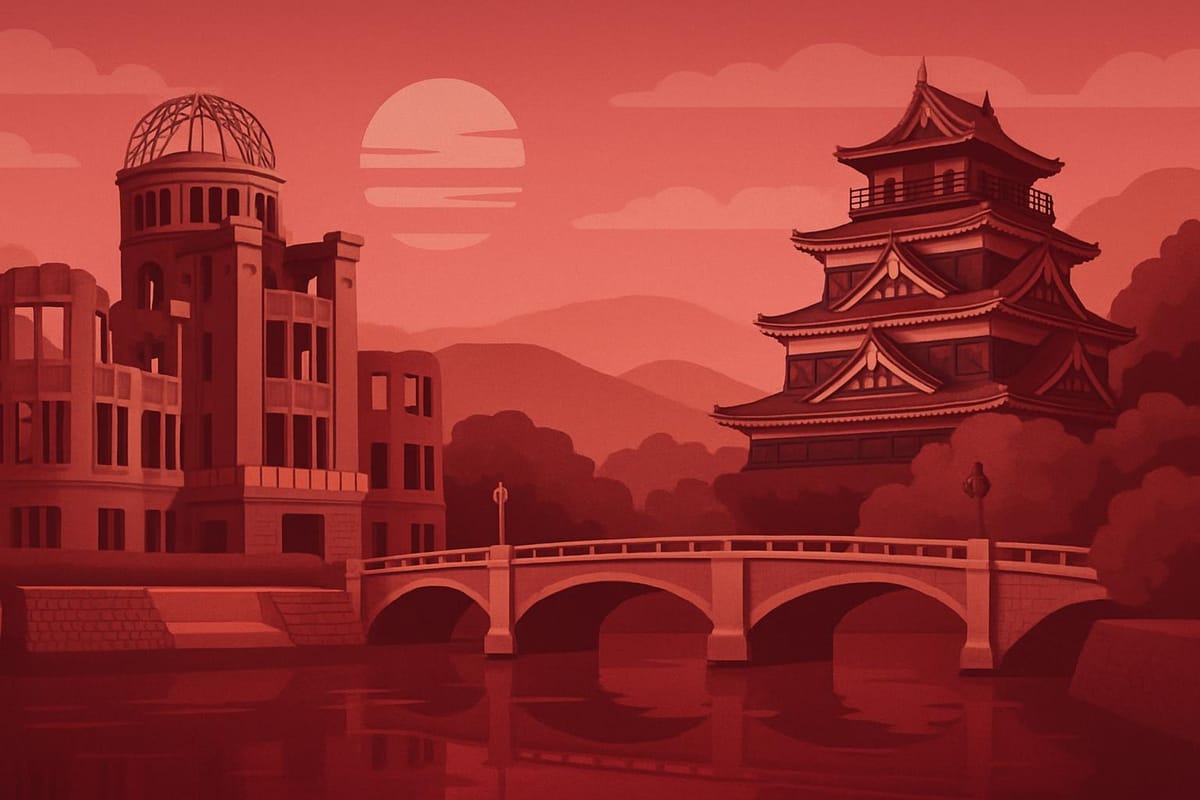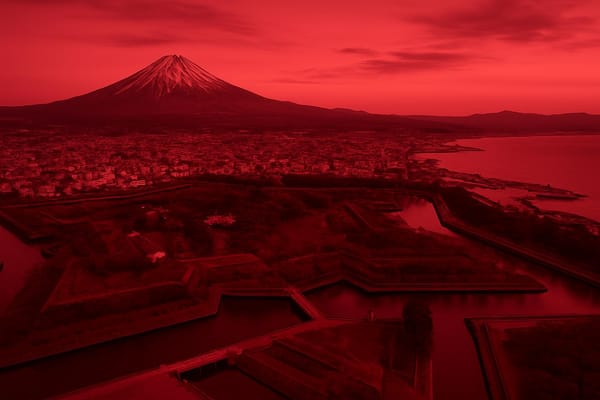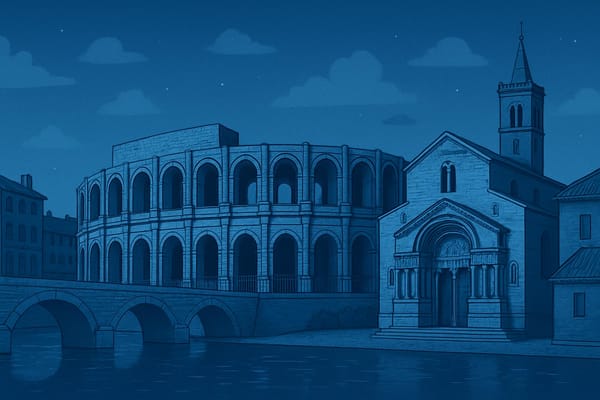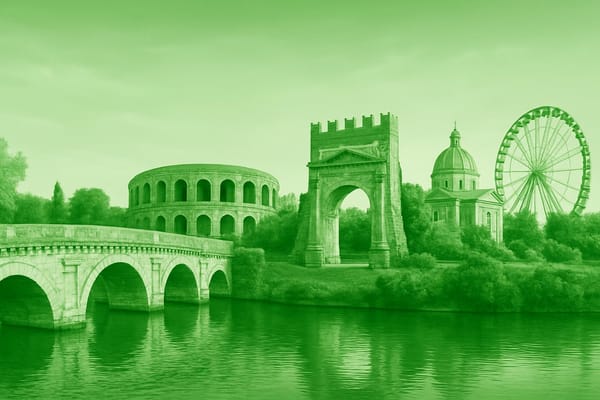Hiroshima
Discover Peace Memorial Park, Atomic Bomb Dome, Itsukushima Shrine, floating torii & okonomiyaki.

Important things to know about Hiroshima
Hiroshima, a dynamic coastal city in Japan, blends modern urban life with deep-rooted regional character, where wide rivers carve the landscape and a bustling port links the city to the Seto Inland Sea and beyond. Residents move through a network of efficient transportation - trams, trains and bridges - that knit neighborhoods, universities, and business districts into a compact, walkable urban fabric; the local economy mixes high-tech manufacturing, shipbuilding, and research with thriving small businesses and creative industries, giving the city a pragmatic yet innovative pulse. Everyday life in Hiroshima reflects a strong sense of community and civic engagement, visible in neighborhood markets, university campuses, and seasonal events that celebrate local food and craft; the culinary scene focuses on fresh seafood and regional specialties, while cafés and izakayas provide relaxed social spaces that shape the city's lifestyle. Green corridors and riversides offer residents quiet respite amid dense development, supporting cycling, walking and outdoor markets that sustain local rhythms. Demographically, Hiroshima balances a maturing population with students and young professionals attracted by employment opportunities and cultural institutions, creating a multi-generational urban mix that is both traditional and forward-looking. The city’s identity is marked by an enduring spirit of resilience and renewal, fostering public initiatives in education, urban planning and environmental management aimed at sustainable growth. As a center of commerce, learning and everyday life in Japan, Hiroshima presents a layered, human-scale urban experience where history, industry and community converge to shape a modern city focused on quality of life and continued reinvention.
Sightseeing hot-spots in Hiroshima
Hiroshima offers a powerful blend of history and renewal that makes it a must-see for travelers interested in meaningful sightseeing. At the heart of the city, Peace Memorial Park and the iconic Atomic Bomb Dome stand as enduring symbols of resilience; the park's tranquil layout and reflective monuments invite visitors to learn about the past at the Peace Memorial Museum while contemplating hope for the future. A walking tour around the park reveals poignant memorials, preserved ruins and well-maintained green spaces that capture both sorrow and the city's commitment to peace, making these attractions essential stops on any Hiroshima itinerary.
A short ferry ride from the city center brings you to the legendary island of Miyajima, home to the floating torii gate of Itsukushima Shrine-one of Japan’s most photographed sites. Miyajima’s cedar-lined paths, charming streets, and panoramic views from Mount Misen provide diverse sightseeing experiences, from sacred architecture to peaceful nature trails. The island’s deer and traditional ryokan atmosphere complement the shrine’s spiritual aura, and timing your visit for high tide ensures the best views of the shrine seemingly standing on the sea, a highlight for photographers and culture seekers alike.
Beyond these signature sites, Hiroshima’s urban attractions and culinary scene enrich the sightseeing experience. Explore the reconstructed Hiroshima Castle, stroll the manicured paths of Shukkeien Garden, and savor the city’s famous okonomiyaki-a savory pancake that reflects Hiroshima’s food culture. Efficient tram lines and easy access to bullet trains make travel to nearby attractions simple, so packing a mix of museums, gardens, local cuisine, and serene island landscapes will help you enjoy the best attractions in Hiroshima and create a memorable travel itinerary.
Hotels to enjoy in Hiroshima
Hiroshima offers a rich range of hotels in Hiroshima that cater to every travel style, from budget-friendly business stays to luxurious waterfront retreats. Many visitors choose accommodation close to the Peace Memorial Park for the convenience of walking to museums, monuments, and serene riverside views, while others prefer hotels near Hiroshima Station for fast access to regional trains and the shinkansen. For island excursions, properties that include guided trips to Miyajima are especially popular, and several hotels boast panoramic views of the Seto Inland Sea. Whether you want a modern urban high-rise with a sky lounge, a boutique hotel near local markets, or a traditional ryokan-style experience with an onsen-like bathing area, Hiroshima hotels provide a balance of convenience, culture, and comfort that makes exploring the city straightforward and enjoyable.
Beyond location, the best hotels in Hiroshima focus on amenities that matter for both leisure and business travelers, including free Wi-Fi, on-site dining featuring Hiroshima specialties like okonomiyaki and fresh oysters, luggage storage, and multilingual concierge services for booking ferry trips and local tours. Families will find family-friendly rooms and child-friendly menus, while solo travelers can choose capsule hotels or compact business rooms that maximize efficiency. For those searching "cheap hotels in Hiroshima" or "luxury hotels Hiroshima," seasonal Hiroshima hotel deals and early booking discounts can improve value, and properties near the Peace Memorial area or Hiroshima Station often provide the best combination of price and accessibility for sightseeing, dining, and transport connections.
Restaurants to try in Hiroshima
Hiroshima restaurants offer a vibrant blend of tradition and innovation, where every meal tells a story of regional Hiroshima food culture. The city is world-renowned for Hiroshima-style okonomiyaki, a layered savory pancake stacked with cabbage, noodles and a fried egg, cooked on a hot teppan in front of you; this iconic dish anchors many local menus and is a must-try for visitors exploring Hiroshima dining. Beyond okonomiyaki, the region is famous for plump, briny oysters, enjoyed grilled, deep-fried as kaki furai, or simply fresh in season, reflecting the bountiful Seto Inland Sea. Small markets, lively stalls and cozy local izakayas add texture to the culinary scene, while modern chefs reinterpret classic flavors, creating a dynamic tapestry of tastes that makes searching for “best Hiroshima restaurants” rewarding for food lovers and travel planners alike.
For travelers seeking the full spectrum of tastes, a thoughtful Hiroshima restaurant guide helps uncover everything from casual street eats to refined seafood-focused dining with views of the harbor or the iconic torii of Miyajima. Seasonal ingredients drive menus across the city and pairing local sake with fresh seafood or a hearty plate of okonomiyaki reveals why Hiroshima dining is both authentic and approachable. Neighborhoods bustle with friendly chefs and bustling counters where conversation is as integral as cuisine, and sustainable sourcing practices are increasingly prominent among establishments proud to showcase local produce and fish. Whether you’re after the smoky, layered comfort of an okonomiyaki or delicate grilled anago and oysters, Hiroshima’s restaurants reward curiosity with deep flavors and memorable experiences.
Best shopping stops in Hiroshima
Hiroshima is a vibrant destination for shoppers, where the best Hiroshima shopping experiences cluster around lively streets and modern malls. Strolling down the covered Hondori Arcade you’ll find a mix of international fashion, Japanese boutiques and souvenir shops that make shopping in Hiroshima both convenient and atmospheric. Nearby, Hiroshima PARCO and the area around Hiroshima Station offer department store luxury alongside electronics and trendy lifestyle goods, while weekend markets and side alleys hide artisanal finds. Whether you’re hunting for the latest streetwear, traditional crafts or everyday bargains, the city’s blend of pedestrian-friendly arcades and contemporary malls ensures visitors enjoy diverse choices and easy access to both well-known brands and local designers.
For authentic Hiroshima souvenirs focus on specialties you can’t find elsewhere: momiji manju, the maple-shaped sweet famous on nearby Miyajima, and savory items tied to the region like Otafuku sauce, essential for making the city’s distinctive okonomiyaki at home. Craft lovers should seek out shops selling regional lacquerware and handcrafted glass pieces, while food markets and bakery windows tempt with local flavors perfect for gifts. Many department stores and selected shops offer tax-free shopping for tourists, making it easier to bring home keepsakes. Exploring both the bustling downtown shopping streets and the quieter craft shops on the periphery will give you a well-rounded sense of Hiroshima’s retail scene and leave you with memorable finds that reflect the city’s culture and culinary pride.
Nightlife highlights in Hiroshima
Hiroshima’s after-dark scene is a lively mix of traditional charm and modern entertainment, where Hiroshima nightlife comes alive around Nagarekawa and Hondori shopping arcade. From cozy izakaya serving fresh seafood and steaming okonomiyaki to stylish Hiroshima bars pouring local sake and craft beer, the city offers options for every mood. Strolling the neon-lined streets you’ll find intimate cocktail lounges, bustling standing bars, and friendly pubs frequented by locals and travelers alike, making the nightlife in Hiroshima feel both authentic and welcoming. Food lovers can pair late-night eats with regional drinks, while photo-ready riverfront views add atmosphere to a memorable evening.
For music and dancing, Hiroshima hosts a variety of venues ranging from intimate live houses with indie bands to energetic nightclubs that keep the party going until dawn, so the Hiroshima nightlife calendar is rich with live concerts and DJ nights. Karaoke rooms are plentiful for groups wanting a private sing-along, and seasonal festivals often spill into the streets with nighttime performances and open-air stalls. Whether you’re hunting for a sleek cocktail bar, a rustic tavern, or a venue showcasing local talent, Hiroshima’s nightlife blends culture, flavor, and entertainment into an after-dark experience that’s easy to explore and hard to forget.
Getting around in Hiroshima
Hiroshima’s travel infrastructure is convenient and well connected: Hiroshima Airport (HIJ), located northeast of the city, is linked to Hiroshima Station by frequent limousine bus services (around 45–60 minutes) and offers domestic flights plus some international connections, while nearby Iwakuni Kintaikyo Airport provides low-cost alternatives; for rail travelers, the city is a major hub on the JR Sanyo Line and served by the Shinkansen, making fast connections to Osaka, Kyoto and Tokyo, and local JR and private lines plus the scenic tram (Hiroden) network provide efficient access across the city, to the Peace Memorial Park and to neighborhoods like Hondori; to reach Miyajima, take the JR Sanyo Line to Miyajimaguchi and a short ferry ride to Itsukushima Shrine, a seamless combination of train and boat that is ideal for day trips, while Hiroshima Station itself houses extensive facilities, rental-car desks and bus terminals for onward travel, so whether arriving by air or rail you’ll find clear signage, multilingual support and frequent services that keep Hiroshima’s airport and train situation traveler-friendly and optimized for sightseeing and business alike.
Culture must-see's in Hiroshima
Hiroshima’s cultural landscape is defined by a powerful blend of remembrance and renewal, and visitors often start with the Peace Memorial Park and A-Bomb Dome, which anchor the city’s commitment to peace and education. The Hiroshima Peace Memorial Museum offers moving exhibits that contextualize the past while encouraging dialogue about the future, making it one of the top Hiroshima attractions for those researching Hiroshima culture and history. Beyond the memorial area, the city’s artistic side shines in institutions like the Hiroshima Museum of Art and the contemporary galleries that showcase both Japanese and international talent. Historic sites such as Hiroshima Castle and the tranquil Shukkeien Garden create a contrast with modern urban life, and riding the iconic streetcar is a simple cultural experience that ties neighborhoods together and reveals local daily rhythms.
A short ferry ride from the city brings you to Miyajima, home to the famous Itsukushima Shrine with its dramatic floating torii-an essential image of Japan and a prime entry on many lists of things to do in Hiroshima. Food culture is equally central to the city’s identity: Hiroshima cuisine is renowned for okonomiyaki, fresh oysters, and sweet Momiji Manju, all best sampled in bustling shopping arcades and riverside eateries. Seasonal festivals, the passionate support for the Hiroshima Toyo Carp baseball team, and local crafts and dialect add layers to the visitor experience. Together, these culture highlights make Hiroshima a destination where history, nature, art, and gastronomy come together into a memorable and meaningful travel experience.
History of Hiroshima
Hiroshima's long and complex history is rooted in its strategic location on the Seto Inland Sea, where the city grew from a 16th-century castle town centered on Hiroshima Castle into a bustling port and industrial center by the late 19th and early 20th centuries. The history of Hiroshima before World War II reflects the patterns of modernization that swept Japan, with rapid urban growth, military significance, and cultural development that made the city an important regional hub. That trajectory was abruptly and tragically altered on August 6, 1945, when the world’s first wartime atomic bomb was detonated over the city. The immediate effects were catastrophic: tens of thousands killed, infrastructure obliterated, and survivors-later known as hibakusha-left to cope with severe injuries, radiation sickness, and the long-term social and health consequences. The partially destroyed A-bomb Dome, once the Hiroshima Prefectural Industrial Promotion Hall, became a stark and enduring symbol of the devastation and a focal point in accounts of the bombing. The event is now a defining moment in both local and global narratives, central to discussions of World War II, nuclear warfare, and humanitarian impact, all of which are essential elements when exploring the full arc of Hiroshima’s past.
The postwar chapter of Hiroshima’s story is one of determined reconstruction, remembrance, and advocacy for peace. In the decades after 1945, the city was rebuilt with careful attention to honoring victims and educating future generations; the Hiroshima Peace Memorial Park and the Peace Memorial Museum were established to preserve evidence of the bombing, document survivor testimonies, and promote a message of nuclear disarmament. Hiroshima’s commemoration activities, including the annual Peace Memorial Ceremony held every August 6, attract visitors worldwide and position the city as a global center for peace studies and anti-nuclear activism. Modern Hiroshima blends memorial sites with vibrant urban life-innovative architecture, cultural institutions, and green public spaces-while its shared history continues to shape civic identity and tourism. Efforts by local leaders, scholars, and activists to tell the history of Hiroshima emphasize resilience, the ethical implications of nuclear weapons, and the practical work of creating a safer, more peaceful future, making the city a powerful living classroom for history, memory, and international humanitarian dialogue.



